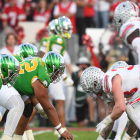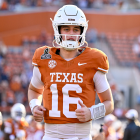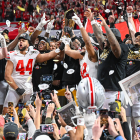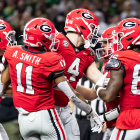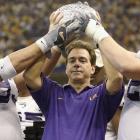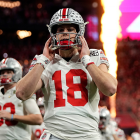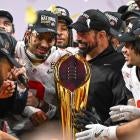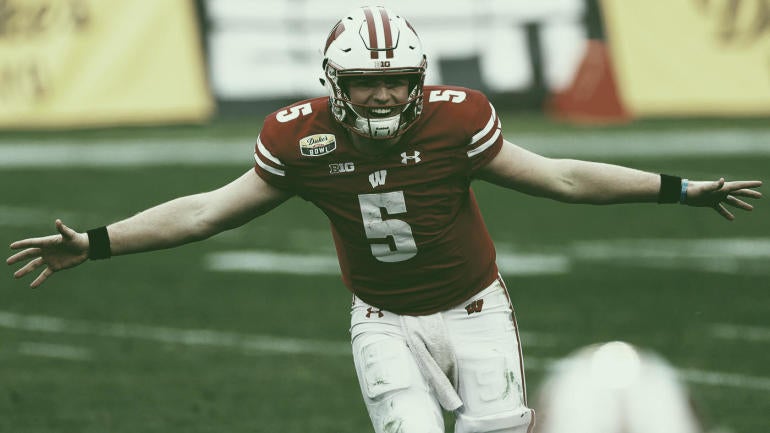
The pantry light in the apartment Graham Mertz shared with four other Wisconsin teammates was on at 3 a.m. Even with five strapping athletes sharing a lot of food in a small space, that seemed odd to the Badgers quarterback.
"I was scrambling around literally in my boxers in the kitchen," Mertz told CBS Sports. "I thought, 'Something is going on.'"
Mertz waited, breathless, maybe 5 minutes. The pantry door slowly opened, a pair of hands from the inside pushing open the door.
"Then I grabbed the guy," Mertz said.
What occurred is at once terrifying and inspiring as college athletics waits on the precipice of unprecedented benefits granted to athletes for their name, image and likeness rights.
The figure inside the pantry was indeed an intruder, a homeless man who had broken into the apartment off Madison, Wisconsin's main drag -- State Street -- searching for food.
"He was eating beef jerky for, like, an hour in our apartment," Mertz recalled. "I got him out. I called our team cop. 'Something happened, you've got to come to the apartment do an investigation.' We went back and watched the footage. He got in at 12:45, and I got him out at 3:15."
What Mertz won't discuss in depth is whether he got physical, actually threw down on the intruder. Safe to say, the encounter was disconcerting and dangerous. It occurred two days before the season opener against Illinois where Mertz threw five touchdown passes.
Wisconsin sources speculate the interaction with the homeless man may or may not have led to a COVID-19 outbreak on the team.
"It's something I've never experienced," Mertz said. "Literally every day, walking in the locker room. Is everybody here? Has someone tested positive? It was a constant, 'Are we OK? Are we not?'"
Against this backdrop, Mertz will be one of thousands of college athletes who will benefit from NIL rights going into effect this week. When midnight on Thursday, July 1 hits, he will have a business plan in place that includes social media, apparel bearing his name and endorsement opportunities.
It will not become a distraction. After what he has been through, how can that be for Mertz, a rising sophomore from suburban Kansas City? He has made it clear to those in his inner and outer circle that football and school will come first.
In terms of his branding, he will be the yes/no guy on offers. That's about it. A teaser for his logo appeared Monday on Twitter. That's served as a teaser for this week as a whole.
Coming soon... pic.twitter.com/XDhapgrRrr
— Graham Mertz (@GrahamMertz5) June 28, 2021
The quarterback's sister will handle his social media account. His dad, Ron, a former Minnesota offensive lineman under John Gutenkunst and Jim Wacker, is business savvy as president of sales for A to Z Wineworks.
The quarterback will not be preoccupied.
"My dad and I had this conversation before I even got to college. I trust him with everything," Graham Mertz said. "'Dad, I'm going to play ball, have fun. I'm going to take care of business on the field. Everything off the field, I'll let you handle it. If you need a yes or no from me, I'll take a couple of seconds to give you a yes or no."
That conversation is being had in some form all over the country this week. Athletes will be able to earn unprecedented benefits with NIL, some of them may be perceived as outlandish.
"There's going to be kids with car deals, absolutely," said a member of the NCAA hierarchy.
That assertion is more about how the NCAA let the issue slide to this desperation point. The association's Division I Board of Directors is expected Wednesday to approve a rules waiver that would put only minimal regulations on NIL benefits. That's ahead of 14 states putting their own NIL laws into effect Thursday. Ten more have passed laws that will begin on later dates.
It will remain that way unless and until Congress intervenes a federal bill overseeing NIL. Most experts at this point agree that's going to be a period of months at a minimum.
Thursday will be one of the most transformative days in the NCAA's 115-year history. Athletes will literally be hitting the "send" key at midnight with their signatures on contracts. The answer might be the Mertz Rule -- none of it should overshadow why we fell in love with college sports in the first place.
The NCAA has contended for decades, in court battles and otherwise, that paying players would sully its product and drive fans away. The opposite has been true. Deregulation of college football television in 1984 led to unrealized interest and riches. Too much, it turned out, to rationalize not rewarding athletes with something more than a scholarship.
With NIL, what was once an NCAA violation is now allowed in the name of whatever amateurism still exists these days. The minds of those set to capitalize have already wandered far afield.
A few minutes after CBS Sports published an NIL story announcing the new rules last week, a Power Five head coach called. The documents obtained by CBS Sports confirmed what many thought: at least the opening days of the NIL era were going to be a free-for-all.
"Let me ask you something," the coach began. He wanted to know if, in this new NIL age, his star player could indeed get a car provided by a local dealer.
After a few awkward seconds, I responded, "It looks like it."
No source with whom CBS Sports has spoken has shot down that assertion. Without federal law saying otherwise, the NCAA doesn't have much of a legal standing to prevent such a vehicle arrangement as long as it's an endorsement.
We can argue whether it is right. For now, it just is.
On Thursday, there are likely to be a handful of deals consummated with some of the top athletes/influencers that could be worth upwards of $500,000. Sources have continually said only the top 2% or so of athletes will get the really big deals.
However, Opendorse CEO Blake Lawrence told CBS Sports everyone will get something -- with 100% of Division I athletes receiving "at least one NIL deal this week". While that figure might seem high, another source providing NIL platform services for athletes put it at "easily 60% and probably more".
"They won't all be four figures, but the sheer quantity of opportunities this week will be enough to make everyone think how big this market is going to be," said Lawrence, whose company has partnered with several schools as a leading athlete marketing platform."
Three quarters of athletes in revenue sports should get an NIL deal in excess of $1,000, Lawrence said, and it's not that hard to put into context.
- Any athlete with 10,000 followers can get $100 per promoted post on social media. A deal for 10 of those equals $1,000.
- Any athlete with his or her own T-shirt would only need to sell 50 at $20 profit apiece.
- Prominent athletes could license their NIL rights and earn royalties. At a 5% royalty, they'd need to account for the sale of $20,000 in licensed products.
- Where there's a market, any athlete could sell 100 autographs at $10 apiece.
- High-profile athletes could get $500 per speaking engagement. Two speeches is $1,000.
That's merely the short road to break into four figures. There are money-making avenues no one has even thought of yet.
"It will change college sports forever," said Mertz, who before Monday hadn't used his Twitter account in two years.
All of it is changing before our eyes. NFL agent Neil Schwartz and his 30-year-old son Jesse were familiar with Cameo, which allows fans to pay for personalized videos featuring celebrities of various degrees giving social media shoutouts. The Schwartzes have converted the idea to Twitter and Instagram in a venture is called Jenloop.
For a price, you can get birthday wishes -- or whatever -- from pro athletes to celebrities (Mama June from "Here Comes Honey Boo Boo" is one of them). Former Ohio State quarterback Cardale Jones is charging $60 per tweet and $50 per Instagram post.
That leads us to Thursday when football players from Alabama, Florida and Georgia will have Jenloop deals in place. Georgia safety Lewis Cine's Instagram page proclaims he is the "No. 1 safety in the USA." When it is allowed, Cine plans to charge $15 per post. If he blows up -- intercepts two passes, becomes All-American, etc. -- flex pricing means that number goes up.
According to the Schwartzes, Cine will be joined by teammates Kendall Milton (running back) and Amarius Mims (five-star offensive tackle), Alabama safety Jordan Battle and Florida linebacker Derek Wingo.
"A lot of guys have a lot of pull … people follow them and listen to them and hear them," Cine told CBS Sports. "Them making money off their name, their likeness and their image, that helps them and their family out."
With NIL, we're way past the debate over whether athletes deserve a "free" scholarship and nothing else. As it stands, that scholarship includes room, board, books, tuition and cost of attendance. For the most part, it doesn't include long-term medical insurance post-graduation. That free scholarship also doesn't extend past the five-year window to complete four years of eligibility. Some legislators are trying to extend both benefits in a federal NIL bill, if one ever passes.
"Yeah, we get a free scholarship in way," Cine said, "based on, low-key, the school kind of owns you. You go off their schedule. You do what they tell you to do. The threatening part is, if you don't, [they] can replace you with someone else who wants an education. Anyone who that says [about free scholarships] kind of has a sour taste in their mouth."
The possibilities seem endless. Before he'd even started a game, Oklahoma quarterback Spencer Rattler was worth $740,000 in social media alone. Arizona has contracted with a production company that specializes in making videos of athletes setting Guinness World Records. It used that company for a promotional video involving Rob Gronkowski, but consider the possibilities if those videos could be monetized for college athletes. Look for YouTube channels and podcasts to continue springing up now that college athletes can be paid for them.
Much has been said and written about the opportunity for female athletes. NIL would allow budding swimmers and gymnasts to profit off their likeness while still retaining their college eligibility while competing in the Olympics. The Cavinder twins, who play basketball at Fresno State, already have 3.3 million followers on TikTok and 500,000 followers on Instagram. Their social media worth alone is projected at $500,000.
The Miami Herald reported Monday that four female athletes from Florida universities are set to cash in on endorsement deals Thursday at midnight when the calendar flips to July 1. The list includes a University of Miami volleyball player, a Florida State soccer player, a University of Florida gymnast and a UCF hurdler.
High school athletes will almost certainly see NIL rights at some point. The National Federation of State High School Associations has rules preventing NIL in place but no way to enforce them. They might be powerless to stop athletes from getting benefits in states already with NIL laws.
Opendorse has already partnered with MOKAN Basketball, a powerful grassroots hoops organization, for "personal brand development". MOKAN is the first such high-school level program to partner with Opendorse. MOKAN alumni include Trae Young and Michael Porter Jr.
Think of a Trevor Lawrence, while in high school, being able to strike an apparel deal regarding his high school jersey. That's already being done by All-Star Sports, a Virginia Beach, Virginia-based company that specializes in one-off jerseys. The company has acquired licenses to sell the high school jerseys of the likes of Tom Brady, Zion Williamson, Patrick Mahomes and Cam Newton, among others.
How long before savvy high school stars acquire those rights themselves?
For those who think competitive balance will be destroyed … how, exactly? There is nothing in NIL that will allow, say, Western Kentucky to make net gains on Alabama. In fact, NIL benefits may allow for money to be paid legally that might have otherwise gone to an athlete under the table.
Fans will still pack The Shoe to watch Ohio State and The Big House to watch Michigan. None of it takes away from Dickie V's excitement over the Duke-North Carolina rivalry. The free market will decide eventually if all of it is worth it.
One NCAA NIL solutions group member suggested NIL will be a living document, tweaked for years as rules and conditions change.
"The fascinating thing is, two or three years ago, the end point was giving athletes NIL, right?" said Oliver Luck, a former NCAA executive who now owns a non-profit NIL company. "Now the end point is unionization, health care for life. The goalposts have changed a little bit, in part because I think the NCAA lost the narrative."
Critics have asked what happens to the psyche of players being paid huge amounts of money for their publicity rights when they have a bad game. The answer? Probably the same thing that happens now. They are destroyed on social media. The key is staying away from the trolls enough to concentrate on the task at hand.
What about losing the locker room? We're way past that, too. NFL locker rooms seem to stay intact despite the quarterback making $40 million and a special teamer making the league minimum.
In fact, we already have a real-world example of how it will work in college.
A few years ago, Oklahoma quarterback Kyler Murray signed a $5 million contract with the Oakland A's. Pro in one sport, amateur in another. Still, money is money. Somehow, the Oklahoma locker room didn't collapse. The Sooners won the Big 12 and advanced to the College Football Playoff.
A few weeks removed from his sophomore season and days away from the NIL era, Mertz has thought about it all.
"Life is all about balance," he said. "You can put all your eggs in one basket and do NIL like crazy, or you can put eggs in your basket and go win games."
![[object Object] Logo](https://sportshub.cbsistatic.com/i/2020/04/22/e9ceb731-8b3f-4c60-98fe-090ab66a2997/screen-shot-2020-04-22-at-11-04-56-am.png)









